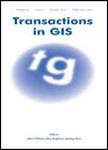版权所有:内蒙古大学图书馆 技术提供:维普资讯• 智图
内蒙古自治区呼和浩特市赛罕区大学西街235号 邮编: 010021

作者机构:Large Scale Distributed Information Systems Lab. Computer Science Department University of Georgia Athens GA 30602-7404 United States Department of Geography University of Georgia Athens GA United States Department of Geography Ohio State University Columbus OH United States
出 版 物:《Transactions in GIS》 (Trans. GIS)
年 卷 期:2006年第10卷第4期
页 面:551-575页
核心收录:
学科分类:07[理学] 081203[工学-计算机应用技术] 0705[理学-地理学] 0835[工学-软件工程] 0812[工学-计算机科学与技术(可授工学、理学学位)]
主 题:Ontology
摘 要:Geospatial ontology development and semantic knowledge discovery addresses the need for modeling, analyzing and visualizing multimodal information, and is unique in offering integrated analytics that encompasses spatial, temporal and thematic dimensions of information and knowledge. The comprehensive ability to provide integrated analysis from multiple forms of information and use of explicit knowledge make this approach unique. This also involves specification of spatiotemporal thematic ontologies and populating such ontologies with high quality knowledge. Such ontologies form the basis for defining the meaning of important relations terms, such as near or surrounded by, and enable computation of spatiotemporal thematic proximity measures we define. SWETO (Semantic Web Technology Evaluation Ontology) and geospatial extension SWETO-GS are examples of these ontologies. The Geospatial Semantics Analytics (GSA) framework incorporates: (1) the ability to automatically and semi-automatically tract metadata from syntactically (including unstructured, semi-structured and structured data) and semantically heterogeneous and multimodal data from diverse sources;and (2) analytical processing that exploits these ontologies and associated knowledge bases, with integral support for what we term spatiotemporal thematic proximity (STTP) reasoning and interactive visualization capabilities. This paper discusses the results of our geospatial ontology development efforts as well as some new semantic analytics methods on this ontology such as STTP. © 2006 The Author. Journal compilation © 2006 Blackwell Publishing Ltd.